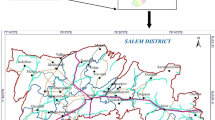Abstract
The spatial differentiation of land use changes of Tuticorin is studied using high resolution LISS III satellite imagery and Maximum Likelihood algorithms. The classification accuracy of 95.2% was obtained. In this study, the land use of Tuticorin is classified as settlement, salt pan, agricultural land, wasteland, water bodies and shrubs. The settlement area is increased to 4.6 km2 during the year 2001 and 2006. The settlement area change is mainly driven by growth of industries and migration of people from peripheral villages. Shrub is increased to 3.63 km2 in the six year period. Water logging due to growth of shrubs in Tuticorin leads to several environmental and health hazard. This study warrants proper urban planning for Tuticorin for sustainable use of resource and environment.
Similar content being viewed by others
References
Arora M K, Agarwal K. 2002. A program for sampling design for image classification accuracy assessment. Photogrammetry Journal of Finland, 18(l): 33–43.
Blaikie P, Brookfield H C, 1987. Land Degradation and Society. London: Methuen.
Chauhan H B, Shailesh Nayak, 2005. Land use/land cover changes near Hazira Region, Gujarat using remote sensing satellite data. Journal of The Indian Society of Remote Sensing, 33(3): 413–420.
CRGEC (Committee for Research on Global Environmental Change) 1991. Report on the working group on land use change. Social Science Research Council, Washington DC.
Csaplovics E, 1998. High resolution space imagery for regional environmental monitoring: Status quo and future trends. International Archives of Photogrammetry and Remote Sensing, 32(7): 211–216.
Foody G M, 2002. Status of land cover classification accuracy assessment. Remote Sensing of Environment, 80: 185–201.
Gan G, 1990. Perspective of urban land use in Beijing. GeoJoumal, 20(4): 359–364.
Guo L Y, Wang D L, Qiu J J et al., 2009. Spatio-temporal patterns of land use change along the Bohai Rim in China during 1985–2005. Journal of Geographical Sciences, 19(5): 568–576.
Huimin Y, Jiyuan L, He Qing H et al., 2009. Assessing the consequence of land use change on agricultural productivity in China. Global and Planetary Change, 67: 13–19.
Liu S H, Sylvia P, LI X B, 2002. Spatial patterns of urban land use growth in Beijing. Journal of Geographical Sciences, 12(3): 266–274.
Liu Yansui, Wang Lijuan, Long Hualou, 2008. Spatio-temporal analysis of land-use conversion in the eastern coastal China during 1996–2005. Journal of Geographical Sciences, 18(3): 274–282.
Mather P M, 1999. Computer Processing of Remotely Sensed Images: An Introduction. 2nd ed. Chichester: Wiley.
Sha A K, Arora M K, Csaplovics E et al., 2005. Land cover classification using IRS LISS III Image and DEM in a rugged terrain: A case study in Himalayas. Geocarto International, 20(2): 33–40.
Turner B L, William B Meyer, 1994. Changes in Land Use and Land Cover: A Global Perspective. USA: Cambridge University Press.
UN Centre for Housing, Building and Planning, 1974. Human Settlements: The Environmental Challenge. London: Macmillan.
United Nations, 1998. World Urbanization Prospects: The 1996 Revision. Population Division, New York.
Weitz J, Moore T, 1998. Development inside urban growth boundaries: Oregon’s empirical evidence of contiguous urban form. Journal of American Planning Association, 64(4): 424–400.
Wolman M G, Fournier F G A, 1987. Land Transformation in Agriculture. Chichester, UK: John Wiley and Sons.
Author information
Authors and Affiliations
Corresponding author
Additional information
Author: John Prince Soundranayagam
Rights and permissions
About this article
Cite this article
Soundranayagam, J.P., Sivasubramanian, P., Chandrasekar, N. et al. An analysis of land use pattern in the industrial development city using high resolution satellite imagery. J. Geogr. Sci. 21, 79–88 (2011). https://doi.org/10.1007/s11442-011-0830-0
Received:
Accepted:
Published:
Issue Date:
DOI: https://doi.org/10.1007/s11442-011-0830-0




